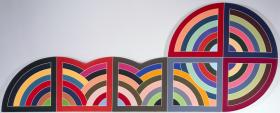1. Before beginning the lesson, students should be able to define and identify or calculate the following parts of a circle: center, radius, diameter, circumference, area, pi. They should know how to use a compass to construct a circle of a given radius.
2. Review parts of a circle.
3. Show Frank Stella’s Raqqa II and related works of art using the PowerPoint. Discuss:
What tools do you think Stella used to create his works of art? What kind of planning might have been involved in the creation of these works? Was precision important in making these pieces? What similarities and differences do you notice in the works in this series? What impact do color and placement of lines and shapes have on the overall design?
4. Introduce the student project by showing a range of student products.
5. Present students with the rubric, which will be used for self-assessment and formal assessment. Go over project requirements handout.
6. Instruct students to draw concentric circles of given radii. They may construct four or more small paintings on heavy watercolor paper.
7. Students record the radius of each of the circles on the handout.
8. Students will color every other circle with crayon, and then paint the remaining circles with paint. Explain the crayon resist process (the paint will not “stick” to the crayon).
9. Students will then cut each of the small paintings into two to four equal pieces.
10. Students will arrange the pieces into a new design and then glue the pieces onto the large construction paper.
11. Have students complete the self-assessment. As a class discuss the designs, and reflect on the role of planning and organization in art making.
- The self-assessment and handout will be used to evaluate students’ ability to find the radius, diameter, circumference, and area of the circles.
- Observation and student projects will demonstrate students’ ability to use proper tools and plan and organize works of art.
- Class discussion may be used to evaluate students’ ability to analyze a work of art.
radius
circumference
diameter
area
concentric
circle
compass
crayon resist
watercolor
pi
center
Frank Stella PowerPoint
handouts
compasses
4x4 heavyweight watercolor paper
large construction paper (black works well)
rulers
watercolor sets
pencils
crayons
tape
erasers
water
cups
brushes
To many artists of Frank Stella’s generation, the highly subjective paintings of the abstract expressionists seemed mannered and self-indulgent. Stella’s response was to systematize the abstract picture using geometry and a strict but arbitrary set of procedures. Explaining that his art “is based on the fact that only what can be seen there is there,” he sought to distill the image to paint and canvas alone. He stripped his paintings of story or statement—even a brushstroke conveyed too much personality. Stella methodically developed images in series, first mapping the designs on paper before transferring them to canvas. Little was left to chance.
Raqqa II belongs to Stella’s aptly titled Protractor Series, begun in 1967. Though never completed, the series was to include thirty-one compositions, each to be carried out in three different formats: interlaces, rainbows, and fans. He titled the paintings after ancient, circular-plan cities. (Raqqa in Syria was an important trade center under the Arab caliphs.) Raqqa II does not lie quietly on the wall. It dominates its surroundings. What at first glance appears like a childlike pattern is actually a highly complex exercise in perception. Bright bands of flat color arc and overlap, promising an illusion of receding space. However, their containment within a strict system of seven shaped and framed units confounds that illusion. The monumental scale and aggressive confidence of Raqqa II typify American art during the 1960s.


